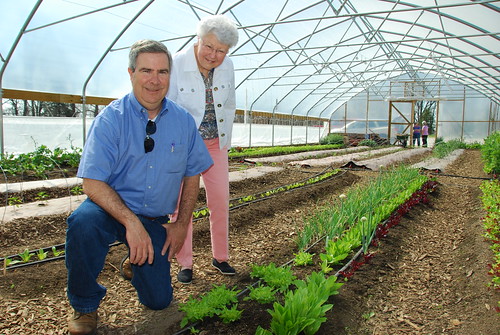
The Share the Harvest Food Pantry uses a seasonal high tunnel to grow fresh fruits and vegetables for people in need.
For the past several years, USDA has been making a concerted effort to increase consumer awareness of food origins. That’s an easy task in Greenview, Missouri, where patrons of the Share the Harvest Food Pantry need only look in the parking lot to see where their fresh produce comes from.
Practically right outside of the front door of the food pantry is a 72-foot-by-30-foot seasonal high tunnel purchased and constructed with financial assistance from the USDA’s Natural Resources Conservation Service.
Judy Wimmer, food pantry director, said the pantry had been using raised beds and another nearby garden spot to grow summer vegetables to distribute to low-income families.
“We realized that the produce we were growing and bringing into the food pantry was very popular,” Wimmer said. “So many mothers tell me that they just come here for the fresh vegetables. They really want fresh vegetables, but they can’t afford to buy them at the store.”
With a strong demand and a limited supply of fresh vegetables, Wimmer considered what could be done to grow more fresh produce for the 1,000 families that the food pantry serves. When she attended a tour sponsored by NRCS and the Camden County Soil and Water Conservation District, she had an idea. One of the stops was at a high tunnel on a private farm just a few miles from the food pantry.
“I thought, ‘it sure would be nice to have one of those high tunnels,’” she said.
She contacted her local NRCS district conservationist, Dan Silberberg, who helped her through the application process. The food pantry’s application was approved, and NRCS provided her assistance to install a high tunnel and a micro-irrigation system and to lay mulch. The high tunnel was built in July 2013.
“We would not have been able to do this without NRCS’ assistance,” Wimmer said.
By year’s end, it supplied more than 500 pounds of tomatoes, 270 one-gallon bags of greens, and 240 pounds of cucumbers. Sheila Morse, food pantry garden manager, said she plans to use the high tunnel year-round to supply a wide variety of healthy produce.
“This will benefit families immensely,” Morse said. “This food is fresh. The nutritional value is a great benefit.”
Morse said the produce she and volunteers grow is not certified organic, but she follows organic-growing practices. This spring she also purchased 2,000 earthworms and released them into the soil under the high tunnel to improve the soil’s health.
Silberberg says the nonprofit Share the Harvest Food Pantry qualified as a non-traditional customer for the Environmental Quality Incentives Program. It is one of about 500 seasonal high tunnels constructed in Missouri with NRCS assistance totaling about $2.5 million since 2010. Nearly all of those are on private farms.
“It’s going to increase their vegetable production, and they give the produce to the community,” Silberberg said. “It’s nice that some of these local people are getting fresh vegetables. And it’s only 90 feet away.”
This September, USDA is celebrating the many opportunities and benefits provided by conservation by highlighting stories like this one. To get started with NRCS, visit your local USDA Service Center or www.nrcs.usda.gov/GetStarted.
No comments:
Post a Comment